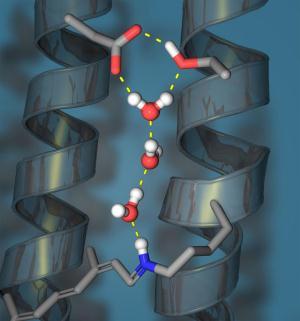 |
Three internal water molecules (red-white) in the protein transport a proton from top to bottom.
[Credit: RUB] |
The researchers in Bochum discovered that a chain of only three water molecules is formed for just a few thousandths of a second to transfer the protons into the interior of the protein.
Water molecules lead the way
The protein kills two birds with one stone. The water molecules are disordered during the release phase, which prevents the protons from being transported in the false direction. Only during the uptake phase, they are correctly aligned and can conduct protons. These results are the solution to the riddle as to why proton transfer only functions in one direction at the uptake side and why the protein is capable of effective and directional pumping. "This paper, together with the two preceding publications, now constitutes a trilogy which supplies a full explanation for the proton pumping cycle at an atomic level", summarizes Prof. Gerwert.
Experimental physics and theoretical chemistry combined
The researchers combined experimental physics with theoretical chemistry to be able to observe the processes with a high spatial and temporal resolution at a nano-level. Steffen Wolf simulated the structural changes within the protein using biomolecular computer simulations (molecular dynamics simulations). Erik Freier subsequently verified the effects experimentally using a special kind of vibrational spectroscopy developed by Prof. Gerwert (time-resolved step-scan FTIR spectroscopy). "This interdisciplinary interplay, which showed that the individual components of the protein are as precisely synchronized as the gears of a machine, was the key to success", says Prof. Gerwert.
As in water, so in the protein
The protein arranges the three water molecules so skillfully that they transport the protons using the physico-chemical Grotthuss mechanism. In the 1950s, the Nobel Prize winner Manfred Eigen elucidated this mechanism to explain extremely rapid, non-directional proton transport in water. Surprisingly enough, the publications of the RUB researchers now reveal that amino acids coupled with protein-bound water molecules can give this extremely rapid transportation a direction of movement. Prof. Gerwert's team was thus able to augment Manfred Eigen's results and apply them to protein research.
Effective conversion of light energy into chemical energy
The group of research scientists in Bochum primarily works with the membrane protein bacteriorhodopsin, which is used by certain bacteria to carry out an archaic form of photosynthesis. Bacteriorhodopsin creates a proton concentration gradient by transporting protons from the interior to the exterior of a cell. Other proteins use this gradient to produce ATP, the universal cellular fuel. It is important that the proton transport has a specific direction and that spontaneous backflow of protons is prevented to ensure that light energy can be effectively used.



